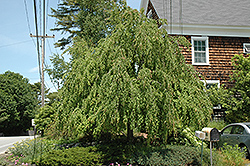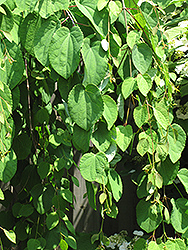Height: 25 feet
Spread: 30 feet
Sunlight:
![]()
Hardiness Zone: 5a
Description:
A graceful tree with cascading, almost weeping branchlets that hang from a pyramidal shape, good fall color; somewhat smaller than the species, a great choice for an accent tree in almost any landscape
Ornamental Features
Weeping Katsura Tree is primarily valued in the landscape for its highly ornamental weeping form. It has bluish-green deciduous foliage which emerges burgundy in spring. The heart-shaped leaves turn an outstanding orange in the fall. The shaggy brown bark adds an interesting dimension to the landscape.
Landscape Attributes
Weeping Katsura Tree is a dense deciduous tree with a rounded form and gracefully weeping branches. Its average texture blends into the landscape, but can be balanced by one or two finer or coarser trees or shrubs for an effective composition.
This is a relatively low maintenance tree, and is best pruned in late winter once the threat of extreme cold has passed. It has no significant negative characteristics.
Weeping Katsura Tree is recommended for the following landscape applications;
- Accent
Planting & Growing
Weeping Katsura Tree will grow to be about 25 feet tall at maturity, with a spread of 30 feet. It has a low canopy with a typical clearance of 1 foot from the ground, and is suitable for planting under power lines. It grows at a fast rate, and under ideal conditions can be expected to live for 60 years or more.
This tree should only be grown in full sunlight. It prefers to grow in average to moist conditions, and shouldn't be allowed to dry out. It is particular about its soil conditions, with a strong preference for rich, acidic soils. It is somewhat tolerant of urban pollution, and will benefit from being planted in a relatively sheltered location. This is a selected variety of a species not originally from North America.
Disclaimer - This resource is provided for informational purposes only and does NOT reflect current availability. Inventory varies seasonally, so we cannot guarantee that every plant will be in stock at all times - please contact your favourite GardenWorks location directly for current availability. It does not include our entire inventory of plants, so be sure to visit GardenWorks to see varieties that may not be represented on this list.


